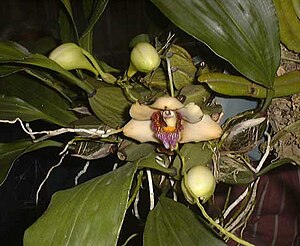Bifrenaria
| Bifrenaria | ||||||||||||
|---|---|---|---|---|---|---|---|---|---|---|---|---|

|
||||||||||||
| Systematics | ||||||||||||
|
||||||||||||
| Scientific name | ||||||||||||
| Bifrenaria | ||||||||||||
| Lindl. |
The plant genus Bifrenaria belongs to the family of orchids (Orchidaceae). The approximately 21 plant species are all found in South America. They usually thrive epiphytically or on rocks ( lithophytic ). They are occasionally cultivated because of their large flowers .
description

Vegetative characteristics
Bifrenaria species are perennial herbaceous plants . All species of this genus form pseudobulbs on a creeping rhizome at a short distance . These are indicated in cross section to be square with several lateral ridges; they consist of a single internode . At the tip of the pseudobulbs there are one or two leaves . The leaves are oblong-oval, often with a long, pointed tip, tapering into a short petiole at the base.
Generative characteristics
The inflorescence appears laterally from the base of the pseudobulbs and grows upright or arched over-leaning. Depending on the species, it only bears one or more flowers. The resupinated flowers are fleshy or waxy and relatively large. The hermaphrodite flowers are zygomorphic and threefold. The three sepals are almost identical in shape, the two on the sides have grown together and with the base of the column to form a sack-like depression. The petals are shaped similar to the three outer petals, but smaller. The lip is three-lobed, narrow at the base and fused with the pedestal. The two side lobes stand upright, the middle lobe is often hairy. The slightly curved column is elongated at the base, where the lip has grown ("column foot"). The stamen sits terminally and is bent down towards the column axis. The two or four hard, yellow pollinia are connected to an adhesive organ (viscidium) via two separate stalks.
ecology
Some Bifrenaria species are known to be pollinated by magnificent bees (Euglossini).
Locations
Bifrenaria species grow as epiphytes in moist forests at altitudes of 200 to 700 meters.
Systematics and distribution
The genus Bifrenaria belongs to Subtribus Lycastinae in the tribe Maxillarieae in the subfamily Epidendroideae within the family of orchid (Orchidaceae). Dressler names Horvatia , Rudolfiella , Teuschera and possibly Xylobium as closely related genera that form a group that can also be referred to as the Subtribus Bifrenariinae. The species of the genus Rudolfiella are occasionally included in the genus Bifrenaria .
The species of the genus Bifrenaria occur in northern South America from the Gulf of Mexico in the north to Brazil, Peru and Bolivia in the south. Brazil has the most species.
There are about 21 species in the genus Bifrenaria :
- Bifrenaria atropurpurea Lindl. : It occurs in southeastern Brazil.
- Bifrenaria aureofulva Lindl. : It occurs in eastern and southern Brazil.
- Bifrenaria calcarata Barb. Rodr. , eastern Brazil.
- Bifrenaria charlesworthii Rolfe , southeastern Brazil.
- Bifrenaria clavigera Rchb. f. , southeastern Brazil.
- Bifrenaria grandis (Kraenzl.) Garay , Bolivia.
- Bifrenaria harrisoniae (Hook.) Rchb. f. , southeastern and southern Brazil.
- Bifrenaria inodora Lindl. , southeastern and southern Brazil.
- Bifrenaria leucorhoda Rchb. f. , southeastern Brazil.
- Bifrenaria longicornis Lindl. , from Trinidad to Bolivia and Brazil
- Bifrenaria mellicolor Rchb. f. : It occurs in Brazil.
- Bifrenaria racemosa (Hook.) Lindl. , southeastern Brazil.
- Bifrenaria silvana V.P. Castro : It occurs in Brazil.
- Bifrenaria stefanae V.P.Castro , southeastern Brazil.
- Bifrenaria steyermarkii (Foldats) Garay & Dunst. , Venezuela, Guyana and northern Brazil.
- Bifrenaria tetragona (Lindl.) Schltr. , southeastern and southern Brazil.
- Bifrenaria tyrianthina (Lodd. ex Loudon) Rchb. f. , eastern Brazil.
- Bifrenaria venezuelana C. Pig f. , northwestern and southern Venezuela and western Brazil.
- Bifrenaria verboonenii G.A.Romero & VPCastro : It occurs in Brazil.
- Bifrenaria vitellina (Lindl.) Lindl. , southeastern Brazil.
- Bifrenaria wittigii (Rchb. F.) Hoehne : It occurs in Brazil.
Culture
Because of the large, colored flowers, the plants can be found in culture. They are kept at temperatures of 15 to 20 ° C and relatively light. There are some cultivated varieties as well as hybrids with Lycaste varieties .
literature
- CH Dodson, CA Luer (2005): Orchidaceae part 2 (Aa-Cyrtidiorchis). In: G. Harling, L. Andersson (Eds.): Flora of Ecuador. Volume 76, pp. 68ff. Botanical Institute, Göteborg University, ISBN 91-88896-51-X .
- Robert L. Dressler (1993): Phylogeny and Classification of the Orchid Family. 173. Cambridge University Press, ISBN 0-521-45058-6 .
- Jürgen Röth (1983): Orchids . P. 133f. VEB German Agricultural Publishing House Berlin.
Individual evidence
- ↑ a b c d e f g h i j k l m n o p q r s t u v Rafaël Govaerts (Ed.): Bifrenaria. In: World Checklist of Selected Plant Families (WCSP) - The Board of Trustees of the Royal Botanic Gardens, Kew . Retrieved July 8, 2018.



